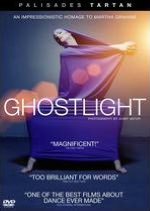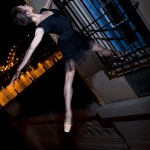by Emily Kate Long
Palisades Pictures and Mannic Productions
Produced and Directed by Christopher Herrmann
Introducing Richard Move as Martha Graham
 The world knows Martha Graham as a dance icon. Ghostlight presents Graham as an icon in every aspect: her personal style is over-the top, her mannerisms are supremely theatrical, her speech is poetic and often cryptic. The tagline of the film, aptly, is “An impressionistic homage to Martha Graham.” It is loosely centered around the creation of Graham’s ballet Phaedra, but the focus is always Martha herself and all her eccentricities. In interviews with performance artist Richard Move and Director Christopher Herrmann (who worked for Graham and knew her personally), the phrase “truth is stranger than fiction” is used to describe Graham, and the film really highlights that. It’s obvious how much of a kick these two got out of making a film tribute to Martha.
The world knows Martha Graham as a dance icon. Ghostlight presents Graham as an icon in every aspect: her personal style is over-the top, her mannerisms are supremely theatrical, her speech is poetic and often cryptic. The tagline of the film, aptly, is “An impressionistic homage to Martha Graham.” It is loosely centered around the creation of Graham’s ballet Phaedra, but the focus is always Martha herself and all her eccentricities. In interviews with performance artist Richard Move and Director Christopher Herrmann (who worked for Graham and knew her personally), the phrase “truth is stranger than fiction” is used to describe Graham, and the film really highlights that. It’s obvious how much of a kick these two got out of making a film tribute to Martha.
Ghostlight features Ann Magnuson as a former Graham student-turned-filmmaker trying to capture the ins and outs of Martha at work—despite financial trouble and personal turmoil for both parties. The exploration of Martha’s relationships to herself, to dance as an inevitable part of her life, and to her former husband Eric Hawkins are not specific or detailed (the feature runs just 80 minutes) but they are highly suggestive. This is clearly a tribute paid with love, and extends its reach by making the viewer want to know more deeply its iconic subject.

Assistant Editor Emily Kate Long began her dance education in South Bend, Indiana, with Kimmary Williams and Jacob Rice, and graduated in 2007 from Pittsburgh Ballet Theatre School’s Schenley Program. She has spent summers studying at Ballet Chicago, Pittsburgh Youth Ballet, Pittsburgh Ballet Theatre School, Miami City Ballet, and Saratoga Summer Dance Intensive/Vail Valley Dance Intensive, where she served as Program Assistant. Ms Long attended Milwaukee Ballet School’s Summer Intensive on scholarship before being invited to join Milwaukee Ballet II in 2007.
Ms Long has been a member of Ballet Quad Cities since 2009. She has danced featured roles in Deanna Carter’s Ash to Glass and Dracula, participated in the company’s 2010 tour to New York City, and most recently performed principal roles in Courtney Lyon’s Sleeping Beauty, The Nutcracker, and Cinderella. She is also on the faculty of Ballet Quad Cities School of Dance, where she teaches ballet, pointe, and repertoire classes.














